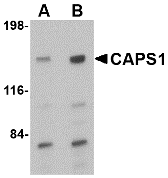CAPS1 (CADPS) Rabbit Polyclonal Antibody
Other products for "CADPS"
Specifications
| Product Data | |
| Applications | IF, IHC, WB |
| Recommended Dilution | WB: 0.5 - 1 ug/mL, ICC: 5 ug/mL, IF: 20 ug/mL |
| Reactivities | Human, Mouse, Rat |
| Host | Rabbit |
| Isotype | IgG |
| Clonality | Polyclonal |
| Immunogen | CAPS1 antibody was raised against a 20 amino acid peptide near the carboxy terminus of the human CAPS1. |
| Formulation | PBS containing 0.02% sodium azide. |
| Concentration | 1ug/ul |
| Purification | Affinity chromatography purified via peptide column |
| Conjugation | Unconjugated |
| Storage | Store at -20°C as received. |
| Stability | Stable for 12 months from date of receipt. |
| Gene Name | Ca2+ dependent secretion activator |
| Database Link | |
| Background | CAPS1 and its related protein CAPS2 encode novel neural/endocrine-specific cytosolic and peripheral membrane proteins. Both are essential components of the synaptic vesicle priming machinery and are required for the Ca2+-regulated exocytosis of secretory vesicles; CAPS-deficienct neurons contain no or very few fusion competent synaptic vesicles, causing a selective impairment of fast phasic transmitter release. CAPS1 acts at a stage in exocytosis that follows ATP-dependent priming, which involves the essential synthesis of phosphatidylinositol 4,5-bisphosphate and is thought to be a specific regulator of large dense-core vesicle fusion. Numerous isoforms of CAPS1 are known to exist; the lower molecular weight bands seen in the immunoblot image are likely to be these isoforms. This CAPS1 antibody is predicted to be specific to CAPS1 and not recognize CAPS2. |
| Synonyms | CADPS1; CAPS; CAPS1; UNC-31 |
| Reference Data | |
Documents
| Product Manuals |
| FAQs |
{0} Product Review(s)
0 Product Review(s)
Submit review
Be the first one to submit a review
Product Citations
*Delivery time may vary from web posted schedule. Occasional delays may occur due to unforeseen
complexities in the preparation of your product. International customers may expect an additional 1-2 weeks
in shipping.






























































































































































































































































 Germany
Germany
 Japan
Japan
 United Kingdom
United Kingdom
 China
China





